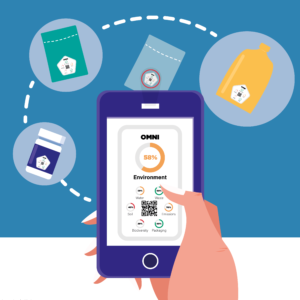One of my favourite sub-theories of policy-making is the Garbage Can theory. This proposes that ideas come forward, enter multiple streams or policy cauldrons, only for some to be rejected and thrown into the garbage can (UK waste bin). Then, when events change or when there’s urgent need for ‘something to be done’, people reach into the bin/garbage can and pull out that rejected idea, and proffer it to powers-that-be saying ‘Here’s an idea for you, Minister / Chief Executive / m’lud’ (delete where necessary). Or something like that!
Step forward the omni-label
An idea a group of us worked on in the 2000s might be set for just such a rescue from oblivion. It’s what back then I catchily called the food ‘omni-label’. The idea is simple – to have one labelling system which pulls together diverse types of information to which consumers really want or deserve access. These include: ingredients (what’s in the food), nutrients (health), environment (carbon, water, biodiversity), processes (how it is made, animal welfare), social conditions (workers, trade) and more.
Food labels are where morals, markets and mouths meet. In market theory, economic efficiencies emerge if consumers are fully informed. Information is one of four Consumer Rights President Kennedy outlined in 1962.
Today, as then, too much information is semi-deliberately withheld. As policy-makers told me in the 1990s, when we were actively pushing for pesticide labelling, ‘If you are worried about residues or which chemical has been used, just buy organic’. This missed the point. Either labelling is about what’s in or on the food or it’s not.
At present, many countries, including the UK, make it compulsory to list ingredients, company information, and nutrition. It took years to win nutrition and allergy information. Demand is growing again for more information to be declared: animal welfare, worker conditions, embedded carbon and water, impact on biodiversity, methods of production and processing. This is omni-labelling!
In the 2000s, the idea won some traction. Defra explored whether full environmental labelling might be possible. By the time PhDs were being done on it, the idea was already in the garbage can.
Ten years on, it’s back. A recent Pre-UN Food Systems Summit webinar was attended by hundreds via Zoom, TikTok and other media.
Five reasons for omni-labelling
Reason 1. Consumers are savvy. They already apply and juggle multi-criteria analysis, weighing up taste, cost, appearance, culture, history, emotion, income and more. Academics and marketers keep researching what shapes food buying worldwide. But data are withheld or partially given. An omni-label would allow consumers to see or search for factors which matter to them – not what pesky marketers want them to buy!
Reason 2. An argument in the past was that omni-labelling is too complex. Technological advance completely alters this. A simple logo could lead, via QR codes scanned by any phone, to the complex truths about food products. Who made it, how, etc. Omni-labelling technology exists and is being applied, but only partially. Why not fully and properly regulated? And scientists have piled up reasons for looking at food as a ‘multi-factoral’ issue. Cambridge veterinarian Professor Donald Broom, for instance, has developed an interesting multi-factoral index which shows it’s possible to capture complexity.
Reason 3. Big Food companies are quietly developing their own labels. With food footprints so deep for carbon, water and biodiversity, the makers of ultra-processed, mass produced brands want to be seen to be doing something. This sounds progressive but, unless subject to public scrutiny and regulation, could leave it up to companies what they declare.
Reason 4. Many apps are emerging. Orijin.io is a company which produces QR-based labelling. A Consortium for Labelling for the Environment, Animal Welfare and Regenerative Farming (CLEAR) was recently launched in the UK. Such initiatives are heartening but could simply add yet more logos. To reframe the market, we need something comprehensive, not adding to information cacophony. State-facilitated regulation is ultimately required to deliver that and to arbitrate on information. Policy processes could begin quickly. Government must take stock, listen and then create a common framework.
Reason 5. The food system faces known challenges on which consumer involvement is essential. Just a few weeks ago, the UK’s Meteorological Service published The State of UK Climate 2020 report. Weather disruption is the new normal. A week earlier, the (English) National Food Strategy recognised the need for systems change and that people need to be helped off the junk food cycle. And a week before that, the Committee on Climate Change again said diet change is needed to meet Zero Carbon targets. The stakes (steaks?) are high. Facing this stream of sobering data, consumers need something to help them navigate. That’s where an omni-label could contribute.
From the waste-bin to whose desk?
Can omni-labelling resolve all the world’s food problems? Of course not. But equally, the demand for clarity, coherence and evidence-based trust in what we eat remains obvious. Sustainable consumption is at the heart of the now eight international Consumer Rights.
Omni-labelling is just the kind of simple idea needed to engage consumers in the pursuit of a better food system. It’s what the UN and governments could deliver at the Food Systems Summit in September, now subject of much argument. It would show the Summit is pro the people not pro unaccountability. And also at the Convention on Biodiversity in Kunming in October, and the Convention on Climate Change in Glasgow in November. If the UK wanted to lead, it could retrieve omni-labelling out of the garbage can and run with it. Not least at home.

